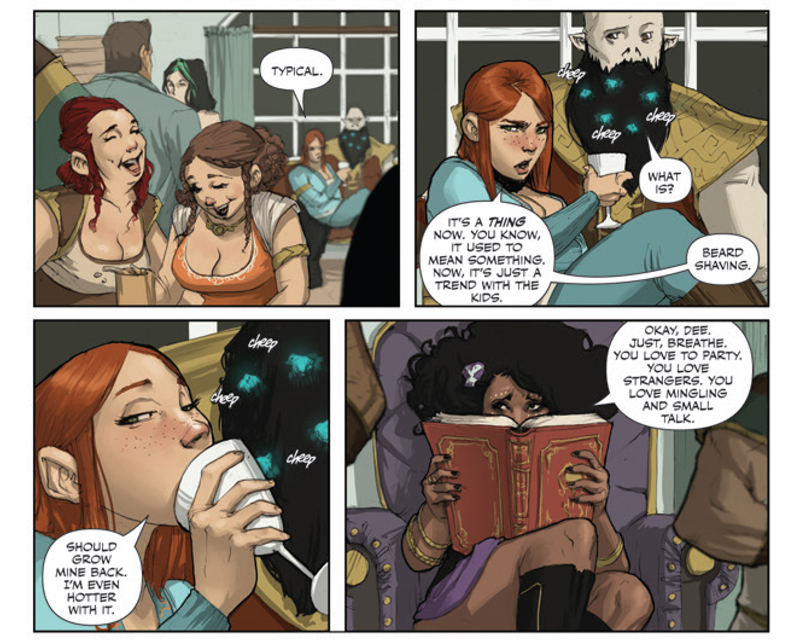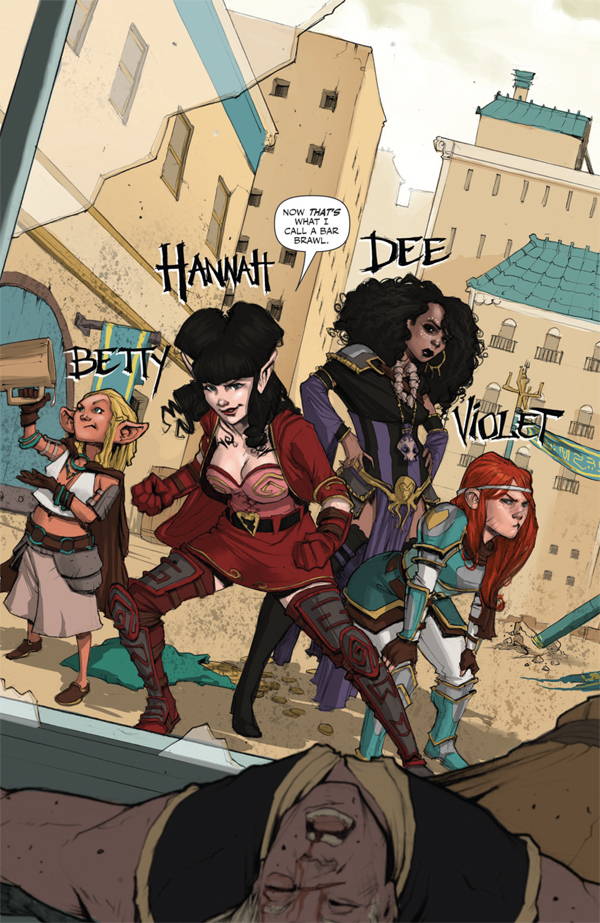In high fantasy, women tend not to get to crush ass. The violent female character exists as an anomaly (Brienne from Game of Thrones), a wild card (Eowyn from Lord of the Rings) or a villain (countless witches and sorceresses). And yet, berserkers and barbarians remain a staple of high fantasy mythos, and women love to bash in an enemy’s head with a club in Skyrim as much as any other player.
Kurtis J. Wiebe’s Rat Queens from Image Comics is a fast-paced, smash-and-bash romp, a comic that doesn’t even reach the end of the first page before someone is thrown through a window. Our anti-heroes, the eponymous Rat Queens, are introduced gleefully participating in a bar brawl, underscoring their status as the rowdy scourge of once-peaceful Palisade, a town they once protected as a mixed band of adventuring misfits.
Rat Queens succeeds in dropping its readers into the story mid-stream because it draws from a genre we know well through RPGs, Lord of the Rings, and a hundred other high fantasy pieces of the like, all inspired by that old tabletop standard, Dungeons & Dragons. Like your basic D&D campaign, the general plot of Rat Queens is barely noteworthy. Fight scenes are arbitrarily woven together through small-town intrigue and just enough obviously-approaching twists to keep the action moving. Instead, the story is much more about these four characters and their development from archetypes into fleshed-out individuals through blood, battle, and a large amount of partying.
Somewhere in the old D&D manual it explains that adventuring is a fringe occupation, and understanding your character means understanding why they chose this over society and a normal life. The first five issues of Rat Queens introduce the challenge for these women of reconciling their inclination toward a violent and counterculture lifestyle with their place in the law and order of Palisade, and the homes and traditions they have abandoned to work as adventurers. Violence doesn’t exist here without consequences or acknowledgement of the greater world. Violet grapples with reconciling her ideals of doing good with the town’s rejection of the band’s high-collateral “protection.” Betty’s would-be love interest Faeyri bows out from the romance because she’s “moved on from the crazy, bar-brawling era of [her] life”.
Add to this formula Rat Queens’ modern take on high fantasy, much touted by Image in their summary for issue #1:
Who are the Rat Queens? A pack of booze-guzzling, death-dealing battle maidens-for-hire, and they’re in the business of killing all gods’ creatures for profit.
It’s also a darkly comedic fantasy series starring Hannah the Rockabilly Elven Mage, Violet the Hipster Dwarven Fighter, Dee the Atheist Human Cleric and Betty the Hippy Hobbit Thief. This modern spin on an old school genre is a violent monster-killing epic that is like Buffy meets Tank Girl in a Lord of the Rings world on crack!
Modern-style archetypes like “rockabilly” or “hipster” or “hippie” become as integral to their character constructions as if they’re a dwarf or elf, a healer, sorcerer, or fighter. All these pieces provide a shortcut to understanding and sympathizing with these women and their existence on the fringe of society even before the story gets the chance to lay much character groundwork. I can understand a world with exes, one-night stands, party drugs, social anxiety, magical calls from nosy parents, and “no fucks to give” as motivations much more than a world based on honor, tradition, feudal ties, and dreams of settling down on a sheep farm.

Wiebe gives us a refreshing change from the popular notion that high fantasy must be “period-appropriate” to some sort of unspecified renaissance-faire time–an idea that more often than not is used as an excuse for sexual violence, and few female characters or characters of color, regardless of an actual historical understanding. By explicitly choosing to reject a historical mode, Rat Queens sets up a universe in which women fighters are as plentiful if not more so than male ones, characters of color abound, and characters are explicitly queer without an eyelash batted.
An interesting example of how Rat Queens works within our cultural understanding to signify a completely different world comes in a few instances where the lead, Hannah, drops some racially-charged dialogue, but in regards to the in-universe Dwarvish race or Smidgen race, instead of race as we understand it. This choice by Wiebe hints at the tensions and differences in history of this separate world, and introduces character faults, while making an attempt to avoid pulling readers of color out of the escapist experience of a world without our rote prejudices.
Roc Upchurch’s artwork underscores Rat Queens’ comfortable offer of escapism to a wide variety of readers with a natural sense of various body-types and fashion styles, of all genders. Characters look comfortable and sexy in their own bodies and clothes. Features and clothing choices feel lovingly crafted to the character, instead of vice-versa. Fleshy bits hang in blessedly realistic ways.
At its core, Rat Queens is fun and simple. It has a sitcom feel; the pace of the storyline and dialogue is manic, and witticisms punctuate drama at intervals so regular you can almost hear the laugh track. It answers a longing for a simple, joyously bloody and reasonably diverse high fantasy action-adventure that allows escapism for a variety of readers, without constant reminders of our universe’s inequalities.
Rat Queens Vol. 1: Sass and Sorcery is available today at your local comics shop, online and at quality bookstores.




